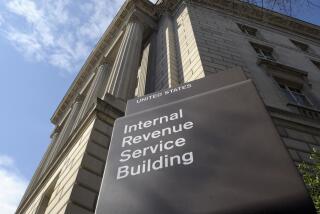YOUR TAXES : PART ONE: INTRODUCTION : 10 most frequently asked questions on tax reform
- Share via
Here are 10 of the most frequently asked questions about the new tax law, and their answers, according to a survey of accounting firms and the Internal Revenue Service.
1. Can I still deduct contributions to my individual retirement plan?
Let’s start with who does not qualify. If you participate in an employer-sponsored retirement plan, such as a 401(k) plan, and your adjusted gross income is $35,000 or more for single filers and $50,000 or more for married couples filing jointly, you can no longer deduct your IRA contributions. You may, however, still make non-deductible contributions, and the earnings will accumulate tax-deferred if you withdraw the money after age 59 1/2.
If your adjusted gross income is less than $25,000 (single filers) or less than $40,000 (married, filing jointly), you can make a tax-deductible contribution to your IRA of up to $2,000 (single) or $4,000 (married) whether or not you have a company-sponsored plan.
For every $10 earned between $25,000 and $35,000 (single) or between $40,000 and $50,000 (married), the deductible contribution is reduced by $2. For example, a single filer with adjusted gross income of $30,000 can deduct only $1,000.
2. Can I still contribute to my company’s 401(k) retirement plan?
The amount you may defer from your salary into your 401(k) plan is now limited to $7,000 a year. Deferrals that exceed this limit will be subject to a 10% tax. If you borrow from your 401(k), remember that under the new law, the interest is no longer fully deductible.
3. Are interest expenses on personal loans still deductible?
The amount of interest on consumer or personal loans (credit cards, car loans, etc.) that you can deduct dwindles over the next five years. In 1987, 65% of your personal interest is deductible. In 1988 it drops to 40%. In 1989 it is 20%, and in 1990 it is only 10%. In 1991, consumer interest will no longer be deductible.
4. Can I still deduct interest on my home mortgage?
Yes. Interest on mortgages for a first or second home remains fully deductible. The interest on a home’s second mortgage is deductible, but generally only if the total of all loans does not exceed the original cost of the home plus improvements.
5. Is mortgage interest on a vacation home still deductible?
Generally it’s still fully deductible. If you rent your home, you must occupy it at least 14 days a year, or 10% of the total number of days your home is rented, for it to qualify for the home mortgage deduction.
If you use your home less than 14 days a year (or less than 10% of the days it is rented), it will be considered rental property and fall under the more stringent rules for rental deductions.
6. Can I still deduct my charitable contributions?
Only if you file an itemized tax return.
7. Can I still shift family income to my children and use them as a tax shelter?
It depends on how old the child is. For a child under 14, unearned income--such as dividends and interest--over $1,000 will usually be taxed at the parents’ marginal rate.
If the child is over 14, all unearned income will be taxed at the child’s marginal rate.
8. What are the changes in long-term capital gains taxes?
In 1987, you can no longer exclude 60% of your net long-term capital gains from taxes. The maximum tax rate on long-term capital gains is 28% in 1987, compared to 20% in 1986.
Beginning in 1988, there will not be any distinction made between long- and short-term capital gains. Thereafter, the maximum tax rate will be 28% (unless a high-income taxpayer has to pay the 5% surtax).
9. Can I still take miscellaneous deductions if I itemize?
Miscellaneous deductions can still be taken to the extent that they exceed 2% of your adjusted gross income. Qualifying deductible expenses include subscriptions to professional publications, tuition for continuing education and job-hunting expenses. Job-related moving expenses, although considered miscellaneous deductions, are not subject to the 2% rule.
10. Are non-reimbursed employee business expenses still deductible?
Yes, with some restrictions. Non-reimbursed employee expenses such as union dues and work uniforms can be taken as miscellaneous itemized deductions. But these deductions are allowed only to the extent that they exceed 2% of your adjusted gross income.
Some business expenses are subject to further limitations: Only 80% of the cost of business meals and entertainment is deductible. This amount is then added to your other miscellaneous deductions to see if you qualify under the 2% rule.
Thanks to:
Thomas Boyle, tax partner, Deloitte, Haskins & Sells, Los Angeles.
Richard Cole, tax partner, Grant Thornton International, Los Angeles.
Andrew Harwood, tax partner, Price Waterhouse & Co., Los Angeles.
Philip Kavesh, tax partner and personal financial specialist, Laventhol & Horwath, Los Angeles.
Lowell Langres, public affairs, Internal Revenue Service.
Dale Sawyer, administrative assistant, H & R Block, Pasadena district.
Sidney Weiss CPA, Sidney Weiss Inc., Woodland Hills.
THE NEW TAX RATES
Taxable Income 1987 Tax Rates Single Filers Married, Filing Jointly 11% $0 to $1,800 $0 to $3,000 15% Over $1,800 to $16,800 Over $3,000 to $28,000 28% over $16,800 to $27,000 over $28,000 to $45,000 35% over $27,000 to $54,000 over $45,000 to $90,000 38.5% over $54,000 over $90,000
Taxable Income 1988 Tax Rates Single Filers Married, Filing Jointly 15% $0 to $17,850 $0 to $29,750 28% over $17,850 to $43,150 over $29,750 to $71,900 33% over $43,150 to $89,560 over $71,900 to $149,25 28% over $89,560 over $149,250
More to Read
Inside the business of entertainment
The Wide Shot brings you news, analysis and insights on everything from streaming wars to production — and what it all means for the future.
You may occasionally receive promotional content from the Los Angeles Times.










